|
Lesson 1
First Peoples of South Dakota
|
|
The past is
as close as yesterday,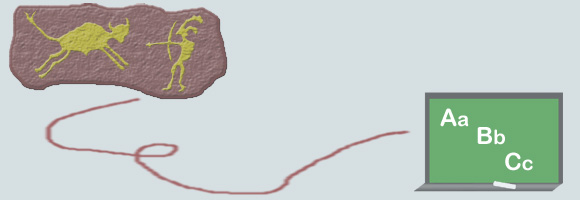
or this morning, when you ate breakfast, or just now, when you read this sentence.
|
The past connects you to your family, your friends, and even to
people you have never met. It connects you to people who lived
right here in South Dakota before it was a state; before there
were cars or computers; before people knew how to read and write.
What
happened to all those people long ago is like one
continuous
thread. It reaches from the Ice Age to this very moment.
Right now.
That is
why South Dakota history is important. It links us together and
tells one story from many. It tells about the land, the climate,
and the people who lived here.
|
| |
|
|
First Peoples
|
|
|
A long time
ago, swampy ponds covered the Badlands of what is now South
Dakota. American camels, small horses, and Columbian
mammoths roamed these swamps. Summers were rainy and cool.
Winters were mild.
|
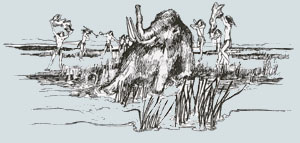
Photo courtesy of University of South
Dakota Archaeology Laboratory
|
We know what happened in one of those swamps over eleven thousand
years ago. A band of Paleoindian hunters killed and cut up two
Columbian mammoths for food. These Clovis hunters were the
first South Dakotans we know about. We know about them because of
the tools and bones they left behind.
The Clovis
hunters left us no written record of their lives. They lived
during a prehistoric period. It was long before we humans
developed writing and reading. But like many ancient peoples, they
left us traces of their lives.
Fragments
of tools and weapons can be found. Slivers of wood or stone from
their houses are buried in the ground. Bones from the animals they
hunted remain behind.
|
|
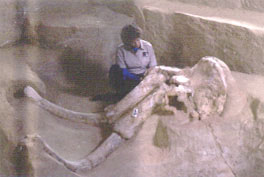
Photo courtesy of South Dakota
Department of Tourism
|
Today,
archaeologists sort through these clues
like detectives. They track the movement of ancient peoples. They
study how human life changed. Often these clues do not tell the
whole story. Archaeologists are not always sure what happened. Did
the Clovis hunters die out with the mammoths and the first horses?
Or did their lives change with the land? This is one of many
unsolved mysteries of the prehistoric world. |
|
Centuries and centuries passed.
The swamps
of South Dakota became wide, sweeping plains. Short, scrubby grass
grew everywhere. Giant bison thundered across the prairies.
A new people came into the area. These Folsom hunters made
beautiful spear points. They picked wild onions and prairie
turnips to eat. They hunted buffalo in the Black Hills. But their
way of life ended. Archaeologists are not sure why. |
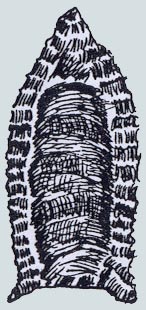
Photo courtesy of University of South
Dakota Archaeology Laboratory
|
| |
|
More centuries passed. Summers grew hotter, drier, longer. New
hunters—the Plains Archaic people—migrated
to South Dakota. Herds of giant bison grew scarce and died out.
Smaller bison replaced them. The people also hunted deer or
rabbit. They ground prairie turnips into powder for eating. They
learned how to store food for long periods of
drought. The Plains Archaic people
lived in small groups because the land had less to give them.
|
|
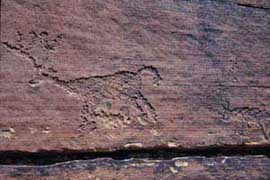
Photo courtesy of Archaeological
Research Center, South Dakota State Historical Society
|
Archaeologists believe these people left the first written
record of life in South Dakota. It is literally carved in stone.
These first writings do not use an alphabet as we know it. They
use signs and symbols. These "pictures" had meaning for
the people who lived here at one time. These records are called petroglyphs.
|
| |
|
|
The climate of South Dakota shifted again about three thousand
years ago. Spring, summer, fall, and winter felt much as they do
now. People began to hunt in bigger groups. They drove large herds
of bison off high bluffs (Unit 3 tells more about this kind of
hunting). These Woodland people traded with native people from the
east. From them, the Woodland people gained new ideas about life
and death. They began to build burial mounds for their
dead. These mounds are in eastern South Dakota.
|
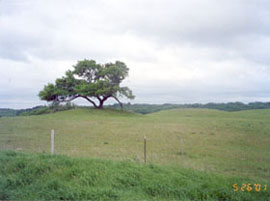
Photo courtesy of Historic South Dakota
Foundation
|
|
|
| Vocabulary |
|
| archaeologists (n.), scientists who
study ancient peoples and the way they lived
centuries (n.),
hundred-year blocks of time
continuous
(adj.), unbroken, having no gaps or holes
|
drought (n.), a long period of dry weather
fragments (n.), small pieces broken off of bigger things
migrated (vt.), moved from one area to another
|
|
|